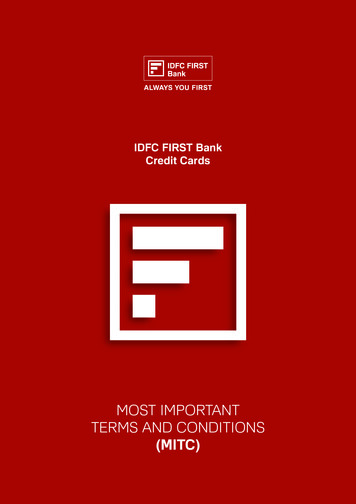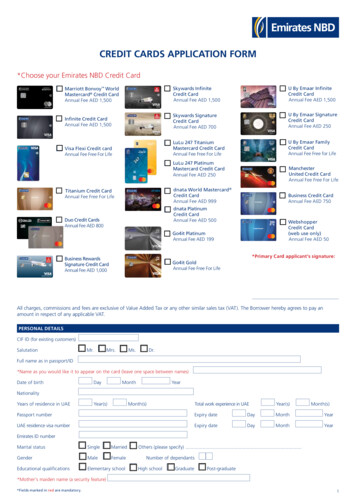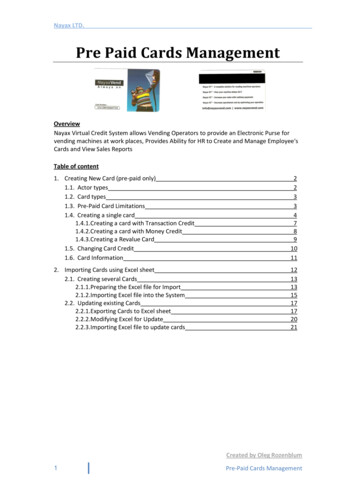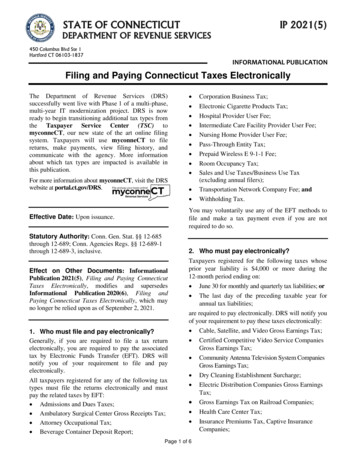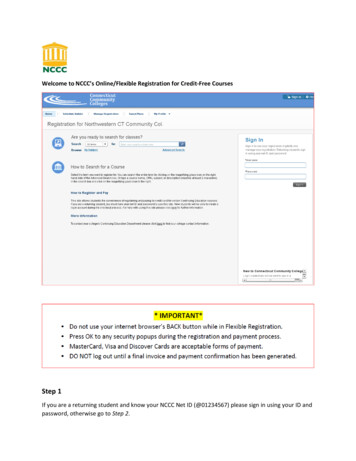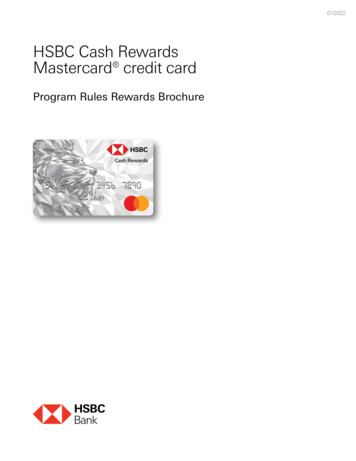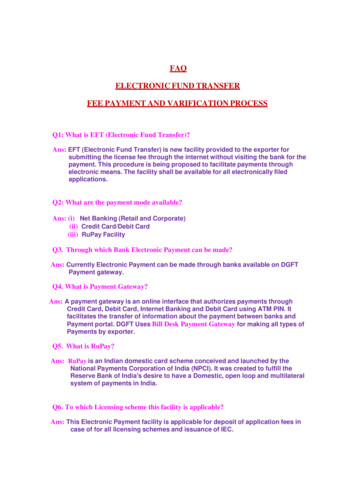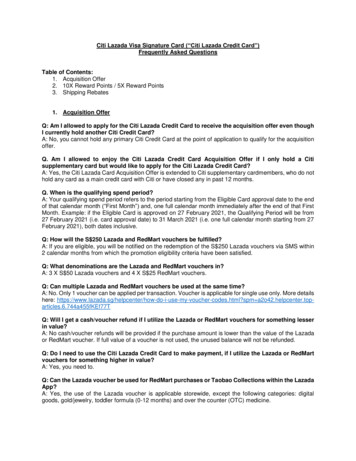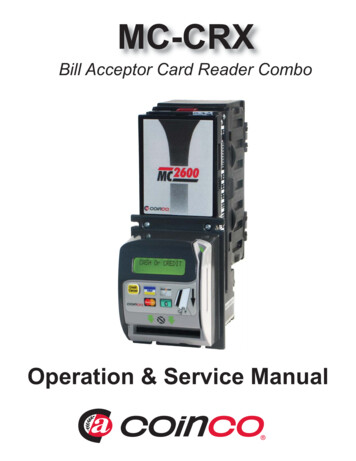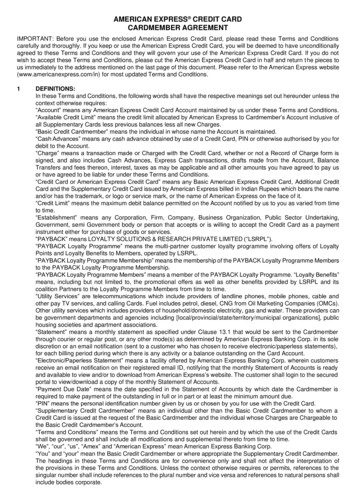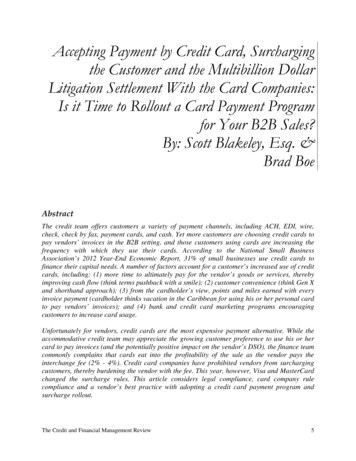
Transcription
Accepting Payment by Credit Card, Surchargingthe Customer and the Multibillion DollarLitigation Settlement With the Card Companies:Is it Time to Rollout a Card Payment Programfor Your B2B Sales?By: Scott Blakeley, Esq. &Brad BoeAbstractThe credit team offers customers a variety of payment channels, including ACH, EDI, wire,check, check by fax, payment cards, and cash. Yet more customers are choosing credit cards topay vendors’ invoices in the B2B setting, and those customers using cards are increasing thefrequency with which they use their cards. According to the National Small BusinessAssociation’s 2012 Year-End Economic Report, 31% of small businesses use credit cards tofinance their capital needs. A number of factors account for a customer’s increased use of creditcards, including: (1) more time to ultimately pay for the vendor’s goods or services, therebyimproving cash flow (think terms pushback with a smile); (2) customer convenience (think Gen Xand shorthand approach); (3) from the cardholder’s view, points and miles earned with everyinvoice payment (cardholder thinks vacation in the Caribbean for using his or her personal cardto pay vendors’ invoices); and (4) bank and credit card marketing programs encouragingcustomers to increase card usage.Unfortunately for vendors, credit cards are the most expensive payment alternative. While theaccommodative credit team may appreciate the growing customer preference to use his or hercard to pay invoices (and the potentially positive impact on the vendor’s DSO), the finance teamcommonly complains that cards eat into the profitability of the sale as the vendor pays theinterchange fee (2% - 4%). Credit card companies have prohibited vendors from surchargingcustomers, thereby burdening the vendor with the fee. This year, however, Visa and MasterCardchanged the surcharge rules. This article considers legal compliance, card company rulecompliance and a vendor’s best practice with adopting a credit card payment program andsurcharge rollout.The Credit and Financial Management Review5
Credit Card Litigation and the Impact on the Vendor’s Payment ChannelAlternativesVisa and MasterCard are defendants in an eight-year class action lawsuit concerning allegedartificially-high interchange fees in violation of the Sherman Antitrust Act. The class actionlawsuit comprises multiple lawsuits against the card companies, brought by retailers such asKroger, PayLess, Safeway and several trade associations. American Express and Discover arenot named as defendants. The suits were consolidated in the U.S. District Court in Brooklyn.On November 27, 2012, the District Court granted preliminary approval of the class actionsettlement. The retailers and Visa and MasterCard agreed to settle under the following terms: (1)cash distribution of 6.05 billion to retailers and vendors that were overcharged during the eightyear period (January 2004 through November 2012); (2) reduction of the interchange fee by tenbasis points for eight months, which is valued at 1.2 billion; and (3) rule changes. The mostsignificant settlement term for vendors in the B2B setting is the rule change that now permitssurcharging the interchange fees to customers. The irony of Visa and MasterCard’s surchargeconcession is that the national retailers suing Visa and MasterCard contend that the surchargeconcession has no value under the settlement as they will not surcharge their customer base, theconsumer. While the irony of the surcharge concession is not lost on the nationalretailer/consumer environment, those same surcharge concessions have opened up a world ofopportunity in the B2B world.On September 12, 2013, the District Court considered final approval of the class actionsettlement. A ruling is expected within the month. Despite the pending court approval, Visa andMasterCard adopted the rule changes, which became effective January 27, 2013. Since theeffective date of the rule change, vendors may now rollout a surcharge program to cardholdersusing Visa and MasterCard to pay invoices.A Vendor’s Evaluation of a Credit Card Payment Program SurchargeRolloutThe Credit and Financial Management Review6
The Vendor’s PerspectiveA credit card payment program benefits the credit and sales teams in ways that traditionalpayment methods do not. The finance team may have a contrary view.The Credit Team’s ViewThe credit team’s mission is to find a way to sell the customer, and have that customer pay forthe sales as agreed. Credit cards achieve this, especially for those customers scored as high risk,as the card company takes the risk of loss. The general benefits may include: Reduced credit riskMinimized bankruptcy riskMinimum documentationMore accurate and timely financial reportingLower administrative expense, depending on how the vendor handles the interchangefee (discussed below)Faster collectionsIncreased productivityImproved customer serviceBy making reduced terms of sale prerequisite for the customer’s credit card use, the vendor mayreap further benefits, such as: Immediate paymentIncreased cash flow, earlier funds availability and positive impact on treasuryoperationsReduced accounts receivableImproved DSOFewer credit approvals and collection activitiesThe Sales Team’s ViewThe sales team’s mission is to sell, both existing and new customers. Credit cards achieve this.The benefits may include: Opening new sales channelAttracting new customers who otherwise do not qualify for termsMore sales opportunitiesEnhanced competitive positionThe Finance Team’s ViewThe finance team’s mission is to manage cash flow and working capital. Credit cards mayimprove revenue, but at what cost? Profit margin erosionMost expensive payment formThe Credit and Financial Management Review7
Credit cards are the most expensive payment channel and interchange fees continue to increase.Given this, the vendor should determine whether a surcharge program balances out these costsand results in cards being competitive with other forms of payment. When evaluating a surchargerollout, a vendor may consider: Impact on Profit Margin: To what extent do interchange fees erode margins? Shouldthe vendor run individual customer profitability models? If margins are large, thevendor may be willing to absorb the interchange fee and offer cards for the customer’sconvenience. If margins are thin, the vendor may consider a surcharge as the onlychoice if adopting a card payment program. The vendor should also consider theimplementation costs (i.e. IT equipment, training, etc.) associated with managing asurcharge program. Implementation costs will vary significantly depending on theway(s) in which the vendor processes customer credit cards: (1) card-not-presenttransactions, (2) swiped transactions, and/or (3) EIPP model transactions. Impact on Sales: Do the vendor’s competitors surcharge customers’ cards? Will asurcharge alienate customers so they may threaten to move their business to acompetitor or will opening the entire customer base to credit cards as an alternativepayment channel enhance your competitive position?The Customer’s PerspectiveFor the customer, the benefits of using a credit card to pay invoices are: Improves Cash Flow: From the day the card is used to pay the invoice, the cardholderhas up to 30 days to pay the card statement that includes the payment of the vendor’sinvoice. The cardholder submits the card statement to the customer for reimbursement.This additional time improves the customer’s working capital and acts as a friendlyform of terms pushback strategy, as it is the card company, and not the vendor, that isgiving the customer additional time to pay. Convenience: Electronic transactions and little paperwork make cards a convenientpayment alternative for customers. Cost: Customer eliminates the cost of processing accounts payable checks.The Cardholder’s PerspectiveIn the B2B transaction where the customer is a small, closely held business organization, thecardholder paying the vendor’s invoice is typically the principal of the company. Cardcompanies offer rewards to the individual cardholder for using the card, such as points andairline miles. The individual cardholder will have their company reimburse them for using theircard to pay the vendor’s invoices, but the cardholder retains the benefit of the points and miles.That the principal is using their card to pay the invoices is not an indicator on its own that thecustomer is in financial difficulty.The Credit and Financial Management Review8
Surcharge Rollout ConsiderationsState Anti-Surcharge Legislation and the Impact on the B2B SaleTo date, only 11 states have passed legislation addressing the ability of vendors to surchargecustomers.1 With regards to the 39 states that have not passed any legislation, there is no legalbar to surcharge customers. The major question for vendors is whether B2B surcharging isallowed in states with anti-surcharge legislation that does not expressly provide for B2Bsurcharging.There is a distinction between consumer and commercial credit card transactions that mayexempt B2B transactions from the purview of some state’s anti-surcharge statutes. ConsiderCalifornia’s anti-surcharge statute, Civil Code §1748.1, which reads: “No retailer in any sales,service, or lease transaction with a consumer may impose a surcharge on a cardholder who electsto use a credit card in lieu of payment by cash, check, or similar means.”2 The legislative historybehind the California statute confirms the intent to protect consumer transactions, rather thancommercial transactions. Similarly, the Texas anti-surcharge law defines a credit card transactionas “a transaction for personal, family, or household use ”3 While statutes in other states arevaguer in their distinction of consumer and commercial transactions, statements from lawmakersin those states suggest a similar focus on consumer transactions. Pennsylvania StateRepresentative, Adam Ravenstahl, referred to the proposed law in Pennsylvania as a “consumerprotection piece of legislation.” The consumer-commercial distinction notwithstanding, a NewYork District Court’s recent injunction against an anti-surcharge statute may soon render thepoint moot.Until October 2013, the state of New York prohibited retailers from surcharging customer creditcard purchases.4 In Expressions Hair Design v. Schneiderman, however, the U.S. District Courtdeclared the statute unconstitutional, on the grounds that it violates the 1st Amendment’sFreedom of Speech. The Court held that the statute’s distinction between the prohibited“surcharges” and the permitted “discounts” is based on “words and labels, rather than economicrealities” and therefore “the statute clearly regulates speech, not conduct”5 The preliminaryinjunction was stipulated on November 5, 2013. Armed with the ruling, the plaintiffs’ attorneysannounced their intention to challenge the remaining states’ anti-surcharge laws. On December2, 2013, the defendants appealed the ruling. Their appeal will be heard before the 2nd CircuitCourt of Appeals.Even before the District Court’s ruling, there appeared to be limited support for anti-surchargebills in the state legislatures. During the 2013 state legislative sessions, anti-surcharge bills wereintroduced in twenty-three states. Utah and Mississippi are the only two of the twenty-three topass anti-surcharge bills.6 Sixteen chose not to pass the legislation: Arkansas, Hawaii, Indiana,Iowa, Kentucky, Maryland, Missouri, Nevada, New Hampshire, New Mexico, Rhode Island,1Exhibit A contains a review of these states’ anti-surcharge laws.California Civil Code §1748.1(a)3Tex. Finance Code § 301.002 (2)4New York General Business Law §5185Expressions Hair Design, et al. v. Eric T. Schneiderman in the U.S. District Court for the Southern District of NewYork. Preliminary Injunction, Opinion, and Order at pg. 21-22 (Doc. No. 63)6Mississippi’s anti-surcharge bill only applies to state-issued credit cards. It is not relevant to this discussion.2The Credit and Financial Management Review10
South Carolina, Tennessee, Vermont, Washington and West Virginia. The five remaining statesare Illinois, Michigan, New Jersey, Pennsylvania, and Wisconsin. The District Court injunctionand promise of further litigation may deter passage of the remaining anti-surcharge bills.Visa and MasterCard Rule ChangesThe Visa and MasterCard rule change that permits surcharging also contains points for thevendor to consider with a surcharge rollout:Notice and Disclosure Requirements: A surcharge rollout program requires that the vendorgive Visa and MasterCard notice of their intention to surcharge 30 days in advance of the rollout.Cardholder’s are to be given notice of a surcharge program in advance of using the card. Thecardholder is also entitled to notice of the surcharge amount. In a card-not-present transaction, the vendor discloses a surcharge prior to the sale (i.e.notice on the web portal used to process the transaction), and the surcharge amount maybe a line item on the invoice if the customer is using the card at the time the order isplaced (no terms). If the customer is qualified for terms and the customer uses the card,then an invoice does not work, as the customer has already been invoiced. A debit memomay qualify. In addition to pre-sale notice, the vendor must disclose the exact surchargeamount for every surcharged transaction. In a card present sale, the vendor discloses the surcharge amount to the customer. Thesurcharge should be reflected on the receipt.Cap on Surcharge: The credit team is to operate as a profit center. However, Visa andMasterCard limits the amount a vendor may surcharge a customer. The surcharge should equalthe cost of processing the credit card transaction (the cost typically is 1.5% to 3%), but cannotexceed 4% of the purchase. If the vendor plans to surcharge both Visa and MasterCard at theuniversal, maximum rate, the surcharge must not exceed the lower of the two blended rates.Otherwise, the vendor may establish a dual surcharge rate, with one covering Visa surchargesand another covering MasterCard surcharges (more on the dual surcharge below). Prior to theclass action settlement, a vendor could only charge a customer a convenience fee that wasintended to offset the vendor’s overhead cost in accepting payment by card.Brand and Product Level Surcharge: Vendors can charge either at the “brand level” or the“product level,” but not both. Brand Level: Applies an equal surcharge to all credit card transactions for a particularbrand (Visa or MasterCard), regardless of the card’s issuer or product type. In thissetting, all Visa transactions receive the same surcharge, while all MasterCardtransactions receive an equal surcharge. Product Level: Applies the same surcharge to all credit card transactions made with aparticular type of Visa or MasterCard. For example, all transactions with the VisaSignature card are surcharged at the same rate.The Credit and Financial Management Review11
Credit card processing costs vary. Vendors should calculate their average processing costs beforedetermining their surcharge level. Vendors who have not yet accepted credit cards may considerVisa and MasterCard’s product-level costs of acceptance, broken down by merchant category.These figures indicate that, on average, brand level transactions have a higher cost than doproduct level. This means the vendor, on average, can pass on a higher surcharge with a brandlevel surcharge rollout. Product level surcharges, however, offer more pricing flexibility. Whilethese gauge potential surcharge rates, the vendor’s actual surcharge rate is based on its merchantdiscount rate.Consistency of Surcharge and Stratification of Customer Base: A vendor’s finance and salesteams commonly class certain customers as favored based on their volume and product mix. Thepreferred customers get most favored pricing, terms and promotional allowances. The sales teamtreats this customer class as protected and will resist surcharging this class. In another setting, itmay be the customer that dictates that the vendor cannot surcharge, such as a state or the federalgovernment. May the vendor protect its favored customers by absorbing some, or all, of the feefor these customers? Can it bend to the demands of a customer refusing to accept a surcharge inorder to preserve the trade relationship? Put another way, do Visa and MasterCard’s new rulesallow the vendor to stratify its customers, waiving the surcharge with one class, absorbing aThe Credit and Financial Management Review13
portion of the interchange fee with another class, and surcharging the entire interchange fee withthe remaining customers?The operative clause in the Visa-MasterCard rule changes is: “A merchant adds the samesurcharge to all Visa [or MasterCard] Credit Card Transactions, regardless of the card’s issuer orproduct type.” At first blush, this might suggest stratification is prohibited, but stratification isnot discussed. This qualifying language instead concerns the brand level-product leveldistinction. Stratification is never prohibited in the settlement agreement nor in thecorresponding materials (i.e. the FAQs on Visa’s and MasterCard’s websites). Had Visa andMasterCard intended to forbid differential treatment for favored customers, they would haveincluded such a provision. But they did not, because disallowing stratification would not beconsistent with the purpose of the settlement, which is to increase competition. Also, the inabilityto stratify surcharges would likely lead many vendors to opt for cash payments, leading to a lossof business for Visa and MasterCard.American Express and Discover Cards: American Express and Discover are neitherdefendants to the class action nor parties to the settlement. The vendor may surcharge AmericanExpress credit card transactions if the vendor only accepts American Express, and so long as thevendor equally surcharges all electronic transactions (including debit card transactions). If thevendor accepts American Express cards in addition to Visa and MasterCard, and still wishes toapply a surcharge on credit card transactions, that vendor will have to negotiate an exceptionfrom American Express rules regarding debit cards (which would violate the Visa andMasterCard rule changes). Discover Financial Services permits surcharging, so long as thevendor imposes equal surcharges on other rival credit card transactions.Debit Cards: Debit card transactions may not be surcharged. The vendor may have, on itsinternet payment portal, a prompt requesting the customer disclose whether the card is a debitcard. However, for the B2B sale, debit card payments should be an insignificant percentage of acustomer’s form of payment. Credit cards are preferred given the additional time for paymentand the cardholder’s rewards.Location: The Visa and MasterCard rule changes apply only to payments made by customers inthe U.S. and U.S. territories.It’s a Negotiation: Vendors should negotiate with credit card companies for exceptions andconcessions. The larger a vendor’s credit card sales volume, the greater leverage that vendor willhave in negotiations.Lowering the Interchange Fee (For the Vendor and the Customer)To reduce risk of fraudulent card use (especially in card-not-present transactions), paymentnetworks encourage vendors to obtain security information with the transaction. There are threedifferent levels of security information, and depending on amount of information passed alongwith a given credit card transaction, the vendor may qualify for a lower interchange rate. Thelevels are:The Credit and Financial Management Review14
a) Level I data includes the cardholder’s billing address, the vendor’s name, the transactionamount, and date of transaction.b) Level II data includes Level I information, the customer’s tax ID number, sales taxamount, and the customer code. Only business, corporate and purchasing cards qualifyfor Level II data.c) Level III data includes Level II information and line item detail (i.e. product code,product cost and item description). Visa only allows Level III data on corporate andpurchasing cards, while MasterCard’s commercial cards qualify for Level III data.While this information can help the vendor lower the interchange rates the customer pays,collecting Level II and III data may increase the processing time for card transactions. Also,collecting this high-level information increases the vendor’s informational security burden(discussed below). Before attempting to lower its interchange rates with additional securityinformation, the vendor should ensure that its credit card sales volume justifies capturing suchdata. Vendors looking to stratify their surcharge program may collect Level II and Level III datafrom a preferred customer class in order to reduce the interchange rate for those customers.Best Practices for a Card Payment Program RolloutInternal Credit Card PolicyA vendor may consider adopting an internal credit card policy as a best practice to ensure thecredit and finance teams are trained with the card company rules and anti-surcharge statutes. Thecard policy addresses the in-house procedures for accepting cards, compliance with cardcompany rules, including brand and product selection and surcharge disclosure, storingcardholder information and mitigating chargeback risks.Vendor’s Card Agreement with Customer, Including Terms and ConditionsLike a new account set-up, where the vendor conditions open credit on a completed creditapplication, including terms and conditions to keep the customer within terms, the vendor maycondition a customer’s card use on the customer agreeing to the vendor’s card agreement form.In the credit card agreement, the “Applicant” should be defined as “the customer buying from[vendor] or any person, natural or legal, who uses their credit card to make payments on behalfof the customer.” In this way, the card payment agreement is applicable to both corporate andpersonal cards, and avoids problems that may arise where a customer pays with multiple cards.The card agreement form provides the vendor with a customer’s personal guarantee andprotections from a cardholder’s unauthorized use dispute and extended chargeback risk. Thevendor may also include a venue provision, or forum selection clause, in the card agreement toaddress anti-surcharge issues. With regards to the choice-of-law clause, the vendor must be surethat either (1) the chosen state has a substantial relationship to the parties or their transaction, or(2) there is any other reasonable basis for the parties’ choice of law.The Credit and Financial Management Review15
Chargeback RiskIf a cardholder disputes a card payment, the card issuing bank may investigate and chargebackthe disputed balance to the vendor. The timeframe for the cardholder to chargeback thetransaction varies depending on the bank, but may extend to 150 days after issuance of thestatement containing the charge. For the vendor, chargeback exposure up to five months after thetransaction is simply too long of a window to carry that risk, especially given the reportingresponsibilities of the credit team to finance. The vendor’s focus of shortening the cardholder’schargeback window is consistent with a policy of promptly dealing with deductions and disputedinvoices. For the cardholder to have chargeback rights up to five months from the transaction isinconsistent with a customer’s good faith in a trade relationship. The vendor may shorten thechargeback window (say 30 days from use of the card to pay the invoice) through a vendor’scard payment agreement form (sample at Exhibit B).Fraudulent Card RiskCard-not-present transactions, such as those via telephone, fax, or Internet, make it more difficultfor the vendor to verify the identity of the customer, as the credit team does not meet thecustomer nor get an imprint of the card. This creates greater risk of fraudulent card use. Beingunaware of fraudulent card use is not a valid defense, and vendors generally assume the risk ofloss for accepting fraudulent transactions. By creating credit risk profiles for its card-payingcustomers (address and card verification, confirmation calls to the customer and a maximumspending limit that can only be surpassed with customer consent), the vendor can mitigate therisk of fraudulent card use.Cardholder’s Privacy RightsAll states have enacted privacy laws to protect individual cardholders from identity theft. Thevendor’s electronic storage of a cardholder’s information imposes on the vendor a duty to protectthe card information from identity thieves.To comply with privacy laws and protect card info stored electronically, vendors may installfirewalls, encryption software and anti-virus software. Vendors can also utilize a dedicatedserver to store cardholder data and limit access to only those employees who require access. Abest case scenario has cardholder data stored on a third party server with restricted access andmasked information. Cardholder information should not be emailed, nor should it be stored onpersonal computers or flash drives. Any paper documents containing cardholder informationshould be secured. When cardholder information is no longer needed, the electronic data shouldbe permanently deleted and the paper documents should be shredded. Firms can be retained toaudit the vendor’s compliance with privacy laws. Privacy laws may also require the vendor tonotify cardholders of a data breach. The notice allows the cardholder to cancel the card and avoidbeing a victim of identity theft.PCI ComplianceThe Payment Card Industry Security Standards Council (PCI SSC) was created by Visa,MasterCard, American Express, Discover, and JCB in 2006 to provide compliance standards forprotecting cardholder data. PCI sets out standards for vendors: Building and maintaining a secure network;The Credit and Financial Management Review17
Implementing safeguards to protect cardholder data;Maintaining a vulnerability management program;Applying strong access control measures;Regularly monitoring and testing network security; andEnforcing an information security policy.Failing to comply with the PCI SSC standards can lead to fines from the card companies and,depending on the level of security negligence, federal fines and criminal prosecution.ConclusionCustomers continue to increase the use of cards to pay invoices, and banks continue theirmarketing efforts aimed at the relatively new B2B revenue stream. To meet the customer’spreference, vendors that do not accept cards have to evaluate a card payment program, includingwhether to surcharge. Those vendors who accept cards may evaluate a surcharge to offset thecosts. The decision to adopt a card payment program is a collaborative one, involving input fromthe credit, finance, and sales teams. It will likely be premised on market segments, competitivelandscape and political considerations, and should address the opportunities and risks discussedin this paper.Scott Blakeley is a principal with Blakeley & Blakeley LLP, where he practices creditors’rights and bankruptcy. His email is seb@blakeleyllp.comBrad Boe is the Director of Credit for Performance Food Group, and the Chairman of theBoard of Trustees for the Credit Research Foundation. His email is bboe@pfgc.com.The Credit and Financial Management Review18
EXHIBIT “A”State Anti-Surcharge LegislationStateStatuteLanguage of StatuteCaliforniaCivil Code (a) No retailer in any§1748.1sales, service, or leasetransactionwithaconsumer may impose asurchargeonacardholder who elects touse a credit card in lieuof payment by cash,check, or similar means.A retailer may, however,offer discounts for thepurpose of inducingpayment by cash, check,or other means notinvolving the use of acredit card, provided thatthe discount is offered toall prospective buyers.§1747.02:(d)"Cardholder" means anatural personColoradoConsumerSurcharges on creditCredit Code transactions–§5-2-212prohibition: Except asotherwise provided insections 24-19.5-103(3)and29-11.5-103(3),C.R.S., no seller or lessorin any sales or leasetransactionoranycompany issuing creditor charge cards mayimpose a surcharge on aholder who elects to usea credit or charge card inlieu of payment by cash,The Credit and Financial Management ReviewLegislative Intent/History Year(if any)Enacted“It is the intent of the 2012Legislature to promote theeffective operation of thefree market and protectconsumers from deceptiveprice increases for goodsand services by prohibitingcredit card surcharges andencouragingtheavailability of discounts bythose retailers who wish tooffer a lower price forgoodsandservicespurchased by some form ofpayment other than creditcard.”Purpose of the Code: (d) 2010“To protect consumerbuyers,lessees,andborrowers against unfairpractices ”(f) “To conform theregulation of consumercredit transactions to thepolicies of the federal“Truth in Lending Act”and federal “ConsumerLeasing Act”Memorandum from Officeof the Attorney General for19
check, or similar means.A surcharge is anyadditionalamountimposed at the time ofthe sales or leasetransactionbythemerchant, seller, or lessorthat increases the chargeto the buyer or lessee forthe privilege of using acredit or charge card. Forpurposes of this section,charge card includesthose cards pursuant towhich unpaid balancesare payable on s Title 42 Chapter739 §42133ff“No seller may impose asurcharge on a buyer whoelects to use any methodof payment, including,but not limited to, cash,check, credit card orelectronic means, in anysales transaction.”Fla.Stat. “Aseller maynotAnn.impose a surcharge on§501.0117( the buyer for electingto use a credit card in lieu1)of payment by cash,check, or similar means,Chapter501 is titled if the seller acceptsbycredit“Consumer paymentProtection” card ”The Credit and Financial M
The credit team offers customers a variety of payment channels, including ACH, EDI, wire, check, check by fax, payment cards, and cash. Yet more customers are choosing credit cards to pay vendors' invoices in the B2B setting, and those customers using cards are increasing the frequency with which they use their cards.
